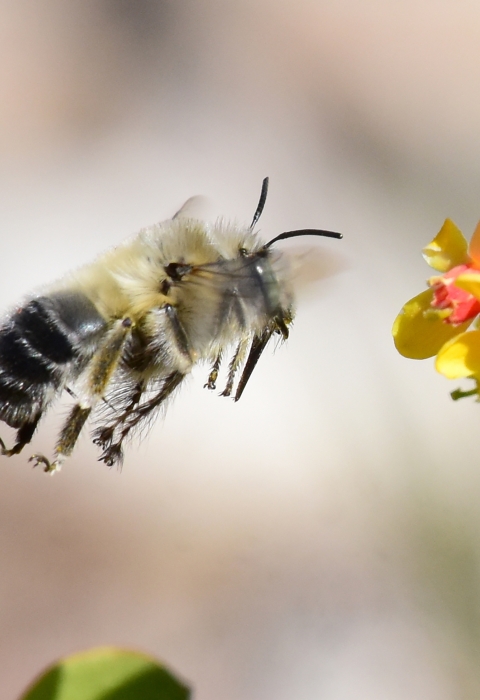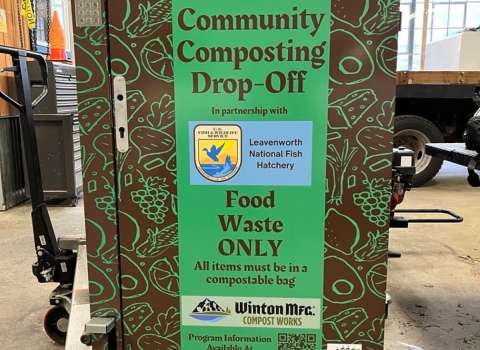Questions and Answers
1. What action is the U.S. Fish and Wildlife Service taking?
The U.S Fish and Wildlife Service is launching the Center for Pollinator Conservation, fulfilling a pledge made during the June 2022 Monarch Summit. The center is national in scope, working across our programs and regions and with external partners to explore and implement solutions to address declining pollinator populations in North America. Initially, it will serve as a collaborative space for land managers, decision and policy makers, scientists, program leaders and others to coordinate and share best practices and approaches.
2. Why is the U.S. Fish and Wildlife Service creating the Center for Pollinator Conservation?
Pollinators provide vital benefits to people and wildlife - keeping animals and plants that we depend on thriving while bringing us food and supporting the economy. The scientific and conservation communities have documented a steep decline of pollinator populations, including the decline of the American bumble bee by 90%, the monarch butterfly by 80% and the Allen’s hummingbird by 88%. Pollinators face big challenges, like climate change climate change
Climate change includes both global warming driven by human-induced emissions of greenhouse gases and the resulting large-scale shifts in weather patterns. Though there have been previous periods of climatic change, since the mid-20th century humans have had an unprecedented impact on Earth's climate system and caused change on a global scale.
Learn more about climate change , pesticide exposure and habitat loss. The center will work to amplify and add to the ongoing efforts to improve the state of pollinators.
3. Who will lead the Center for Pollinator Conservation?
Initial staff include a director, a western monarch coordinator, a national communications coordinator and a biologist. More positions will be added based on the needs of the center and the U.S. Fish and Wildlife Service.
4. Where will the Center for Pollinator Conservation ultimately be located?
Initially, the center will launch as a virtual collaborative space. As the center moves forward, we will announce a physical hub for its operations. The Center for Pollinator Conservation will operate as a hub to work across agency programs and regions, as well as with federal agencies and other interested parties to connect, coordinate and communicate on pollinator conservation efforts. The wider goal is to increase implementation of on-the-ground conservation actions that benefit pollinator species.
5. What is the Center for Pollinator Conservation’s function and focus?
The center functions by working across geographic and programmatic scales and boundaries, and by unifying past, present and future efforts. It is a science and collaboration hub where U.S. Fish and Wildlife Service staff and partners can learn, connect and contribute. Ultimately, the center will improve our collective pollinator conservation impact.
The center will initially focus on three key themes: highlighting the importance of pollinators, understanding and responding to threats and coordinating actions to reverse declines. Anticipated focus for the center’s first year of work includes conducting assessments on the current state of pollinator conservation and science across the U.S. Fish and Wildlife Service; listening to agency programs and other partners across the country about how the center might function, and what it might provide; and developing mid-and longer-term strategies for the center and its work. These focus areas will expand as more practitioners and partners are engaged.
The center will also embody an adaptive approach to one of our organization's biggest conservation challenges. It will support field-based, locally led actions while making recommendations for program and policy improvement to agency leadership.
6. What will happen with existing U.S. Fish and Wildlife Service pollinator efforts in regions and in different programs?
The center will enhance, not replace the excellent pollinator efforts taking place throughout the agency. The center will be a living, valuable part of agency operations.
7. How does the Center for Pollinator Conservation relate to the Memorandum of Understanding (Department of Interior task force) and/or broader “governance” functions?
The July 2022 Department of the Interior memorandum on pollinators established an interagency task force among the Bureau of Indian Affairs, Bureau of Land Management, U.S. Geological Survey, National Park Service and U.S. Fish and Wildlife Service. The task force will perform interagency coordination, discussion and scientific collaboration functions that are specific to addressing the decline in pollinator populations. The bureaus will identify and recommend, as appropriate, priority conservation needs for native pollinators and their habitats. This collaborative will also coordinate implementation of programs for addressing those needs. It is anticipated that the center will play a role in implementing the memorandum.
8. What funding is appropriated for the Center for Pollinator Conservation?
The Science Applications and National Wildlife Refuge System programs with the U.S. Fish and Wildlife Service received new allocations to support the Center for Pollinator Conservation. In FY22, this included $4 million with partial funding for western monarch conservation and additional funding to support inventory and monitoring. Of that, $1 million went to the National Fish and Wildlife Foundation’s Monarch Butterfly and Pollinator Conservation Fund, which the U.S. Fish and Wildlife Service helped initiate in 2015.
9. What is the timeline for the Center for Pollinator Conservation?
A small U.S. Fish and Wildlife Service strike team is focused on implementing a phased approach to ramp up operations after the center opens.
- Phase one is defining the purpose and function of the center - Completed fall 2022
- Phase two is launching the center and soliciting initial feedback from U.S. Fish and Wildlife Service practitioners and interested parties - Estimated completion is winter 2022 to 2023
- Phase three is establishing the center - Estimated completion is spring 2023
Once phase three is complete, the strike team will disband, and pollinator center staff and operations will continue.
10. What will the Center for Pollinator Conservation do for me? How does the center relate to my work?
The center will connect conservation efforts within and beyond the U.S. Fish and Wildlife Service, collect crucial information on pollinator status and trends, and build collaboration. Participants will be more connected to others who are working on pollinator conservation and with external audiences who are interested. We cannot do this without the help of our agency, and we encourage you to think about how you can fit in!
11. How can I participate in the Center for Pollinator Conservation?
During phase two the U.S. Fish and Wildlife Service strike team will solicit feedback to identify existing efforts and needs, and will draft a business plan for operations going forward. There will be frequent opportunities to provide input and collaborate once the center begins to operate.
12. How do our partners and other interested parties participate?
The center will be an inclusive and welcoming space for all who are interested in conserving pollinators. Initially, the center will be focused on aligning and enhancing U.S. Fish and Wildlife Service efforts, but we recognize that this conservation challenge is bigger than us alone. The center will share progress with employees, partners and interested parties and offer collaboration opportunities for partners interested in sharing the work, dedicating resources and conserving habitat for pollinators. The center will strategically interact with others to amplify agency efforts and those of our partners when appropriate. Our strategies will be heavily influenced by the next generation of conservationists, and we are committed to including non-traditional groups and diverse perspectives.
13. Where may I find more information on the Center for Pollinator Conservation?
Learn more about how we're communicating our pollinator conservation work for public audiences.



